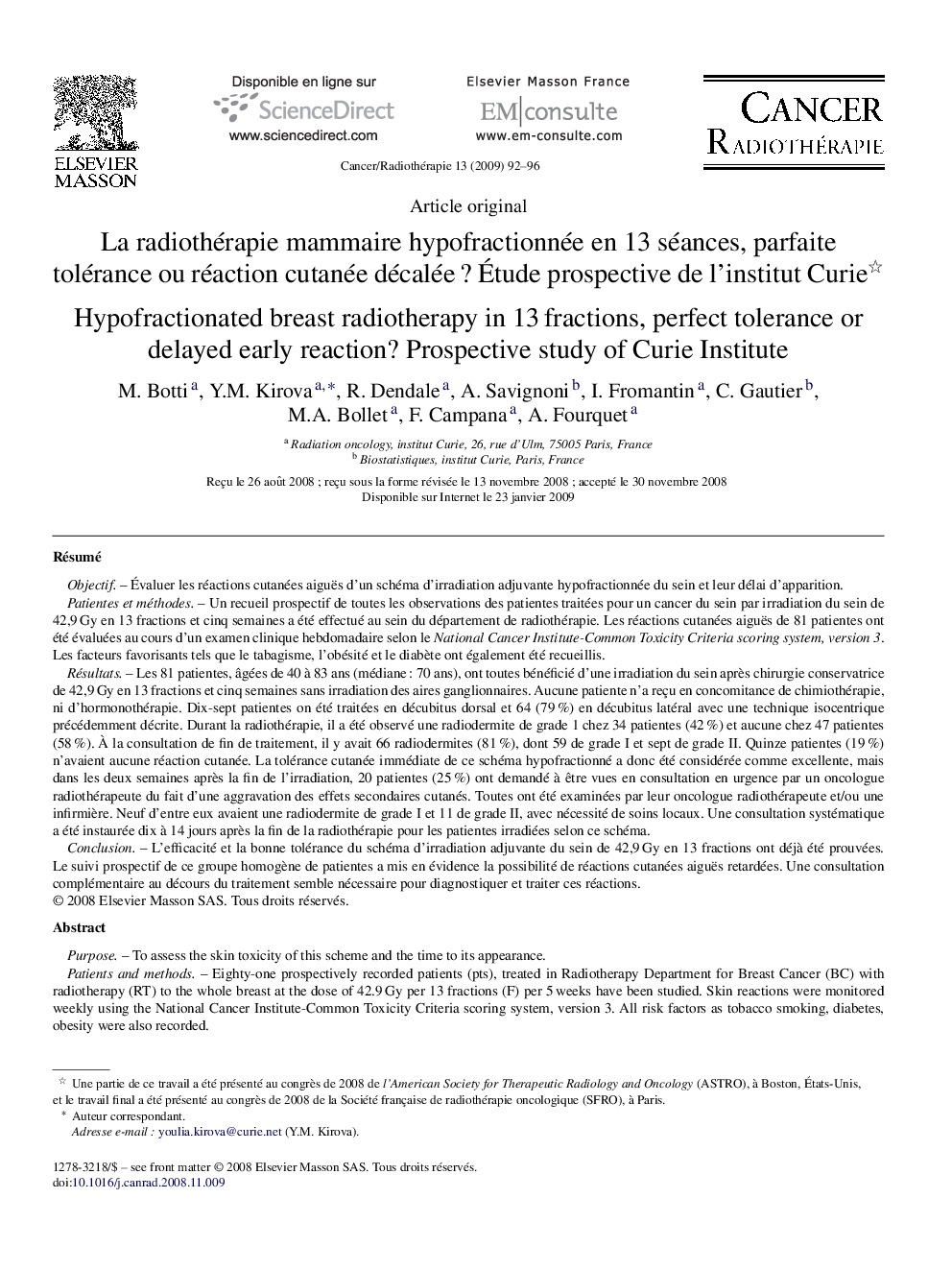| کد مقاله | کد نشریه | سال انتشار | مقاله انگلیسی | نسخه تمام متن |
|---|---|---|---|---|
| 2119044 | 1085272 | 2009 | 5 صفحه PDF | دانلود رایگان |

RésuméObjectifÉvaluer les réactions cutanées aiguës d’un schéma d’irradiation adjuvante hypofractionnée du sein et leur délai d’apparition.Patientes et méthodesUn recueil prospectif de toutes les observations des patientes traitées pour un cancer du sein par irradiation du sein de 42,9 Gy en 13 fractions et cinq semaines a été effectué au sein du département de radiothérapie. Les réactions cutanées aiguës de 81 patientes ont été évaluées au cours d’un examen clinique hebdomadaire selon le National Cancer Institute-Common Toxicity Criteria scoring system, version 3. Les facteurs favorisants tels que le tabagisme, l’obésité et le diabète ont également été recueillis.RésultatsLes 81 patientes, âgées de 40 à 83 ans (médiane : 70 ans), ont toutes bénéficié d’une irradiation du sein après chirurgie conservatrice de 42,9 Gy en 13 fractions et cinq semaines sans irradiation des aires ganglionnaires. Aucune patiente n’a reçu en concomitance de chimiothérapie, ni d’hormonothérapie. Dix-sept patientes on été traitées en décubitus dorsal et 64 (79 %) en décubitus latéral avec une technique isocentrique précédemment décrite. Durant la radiothérapie, il a été observé une radiodermite de grade 1 chez 34 patientes (42 %) et aucune chez 47 patientes (58 %). À la consultation de fin de traitement, il y avait 66 radiodermites (81 %), dont 59 de grade I et sept de grade II. Quinze patientes (19 %) n’avaient aucune réaction cutanée. La tolérance cutanée immédiate de ce schéma hypofractionné a donc été considérée comme excellente, mais dans les deux semaines après la fin de l’irradiation, 20 patientes (25 %) ont demandé à être vues en consultation en urgence par un oncologue radiothérapeute du fait d’une aggravation des effets secondaires cutanés. Toutes ont été examinées par leur oncologue radiothérapeute et/ou une infirmière. Neuf d’entre eux avaient une radiodermite de grade I et 11 de grade II, avec nécessité de soins locaux. Une consultation systématique a été instaurée dix à 14 jours après la fin de la radiothérapie pour les patientes irradiées selon ce schéma.ConclusionL’efficacité et la bonne tolérance du schéma d’irradiation adjuvante du sein de 42,9 Gy en 13 fractions ont déjà été prouvées. Le suivi prospectif de ce groupe homogène de patientes a mis en évidence la possibilité de réactions cutanées aiguës retardées. Une consultation complémentaire au décours du traitement semble nécessaire pour diagnostiquer et traiter ces réactions.
PurposeTo assess the skin toxicity of this scheme and the time to its appearance.Patients and methodsEighty-one prospectively recorded patients (pts), treated in Radiotherapy Department for Breast Cancer (BC) with radiotherapy (RT) to the whole breast at the dose of 42.9 Gy per 13 fractions (F) per 5 weeks have been studied. Skin reactions were monitored weekly using the National Cancer Institute-Common Toxicity Criteria scoring system, version 3. All risk factors as tobacco smoking, diabetes, obesity were also recorded.ResultsAll 81 pts, aged from 40 to 83 years (median: 70 years) received whole breast RT 42.9 Gy per 13 F without lymph node irradiation after breast conserving surgery. There were no pts with concurrent chemo- and/or hormonal therapy. Seventeen patients (21%) have been treated using decubitus dorsal (DD) technique and 64 (79%) using the previously described isocentric decubitus lateral (IDL) technique. During the RT, only 34 pts (42%) experienced grade I skin reactions and 47 pts (58%) were without. At the last day of the breast irradiation, there were 66 (81%) grade I (N = 59) and II (N = 7) skin reactions and 15 pts (19%) without. The early skin tolerance of this scheme was considered to be excellent. But in the 2 weeks after the RT, 20 pts (25%) asked for new clinics with their radiation oncologist as a matter of urgency due to worsening of their skin condition. All of them have been seen by their physician and/or the nurse. Of them, nine presented grade I and 11 presented grade II skin reactions, with necessity of special skin care. The analysis of these results was realized and delayed clinics were organized for all pts treated with this scheme 10–14 days after the end of the radiation treatment.ConclusionsThe breast RT 42.9 Gy/13 F have been previously described as an efficacious and well tolerated scheme. This prospective homogeneous group of patients showed that delayed early skin reactions could appear in some cases. Therefore complementary clinics are needed to detect and treat these reactions.
Journal: Cancer/Radiothérapie - Volume 13, Issue 2, April 2009, Pages 92–96